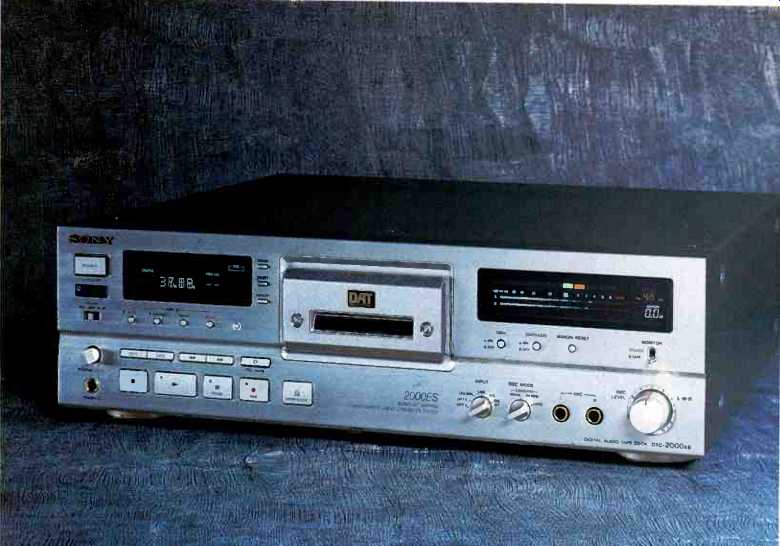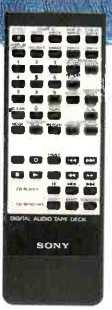

Company Address: Sony Dr., Park Ridge, N.J., 07656.
Technology has not been kind to home recording in recent years. Classic open-reel decks have become something specialist audiophiles rebuild rather than buy. The technology and sound quality of the best CDs and analog records are far be yond the limits of cassette recorders.
MiniDisc and DCC have so far contributed nothing to the state of the art, and the sound of these two "new" digital technologies falls well short of the performance that ordinary DAT recorders have provided for several years. In fact, DAT stands can be easily upgraded simply by connecting a DAT deck to a high quality D/A converter. Although many DAT decks have good D/A converters, there is no question that they sound much better played through converters by Krell, Theta Digital, Wadia Digital, etc.
Digital Audio Tape is an under rated and often unappreciated medium. It was introduced in the wrong way, as the new popular for mat that would replace the cassette-a fantasy in terms of DAT recorders' cost, then and now. Its very real value to music collectors, musicologists, and audiophiles who make their own recordings was largely ignored. Further, little attention was given to packaging DAT recorders with improved micro phones, mixers, dubbing decks, and low-cost digital editors that would have encouraged audiophiles to make high-quality home recordings.
Nor was any real effort made to market DAT as a way of recording local performances and amateur theater and music. Little effort also seems to have been made to market DAT as a way of providing music and sound effects for low-budget dance, theater, and other performances. I recently had the misfortune of suffering through a performance of a ballet company and a semi professional chorale group that thought a slightly off-pitch cassette deck was state of the art; I would vehemently suggest that DAT is a far better solution in supporting performances such as these.
Unfortunately, DAT has little or no commercial software. The initial efforts to sell prerecorded DAT cassettes seem to have died. Thus, there is no point in having a DAT deck in your car or buying a portable play back unit, unless you make your own recordings on a DAT deck with record features.
This does not mean that DAT is dead as a consumer product. A growing number of sound engineers and some audiophiles do use DAT decks make live recordings. I have heard quite a number of home recordings, made with simple miking and without multitracking, which show that there is a great deal to said for amateur performances and simple recording techniques. Some of these DATs are far more involving, in acoustics and emotional impact, than the overprocessed professionalism of far too many CDs.
Some audiophiles also use DATs to archive records or rare CDs. They have discovered that becoming involved in mu sic-in collecting and comparing performances-is often a great deal more fun than the endless search for another tweak or the perfect components. Then, there is the odd reviewer; I, for one, use a Sony DTC-75ES Digital Audio Tape deck to create tapes that I use to screen the equipment I review.
At the same time, my Sony DTC-75ES DAT deck, and other DAT decks I have tried, have some important sonic defects; they lack the ability to properly resolve low-level detail and dynamics. On the plus side, they have flatter frequency response, lower distortion, and less wow and flutter than analog machines. They have done a good job in recording and playing back medium to loud passages, but they have not done an equal job of reproducing the natural sweetness and air of music. They have had trouble reproducing all of the de tail of musical dynamics, and could not record all of the low-level soundstage detail available on the best analog recordings.
The result has been a loss of depth and hall effects. A well-tweaked and restored Revox G36 open-reel analog tape deck-more than two decades old-could do a better job of recording these important aspects o sound quality than DAT machines.
Enter the Sony DTC-2000ES This DAT recorder, which sells for $2,500, incorporates what Sony calls a "high-density, linear A/D converter system" and Sony's Super Bit Mapping technology. The DTC-2000ES uses a delta-sigma converter in its analog-to-digital stage, like some other DAT decks, but it incorporates separate ICs designed to reduce the noise inherent in single-IC systems. The signal is then fed to a pulse A/D converter, which reduces the quantization noise to a theoretical level of -115 dB and reduces the aliasing noise without having to introduce steep filtering into the analog circuit. A decimation filter removes un wanted high-frequency elements with digital processing; it is claimed to reduce aliasing noise by up to 120 dB.
Sony has issued a long and detailed technical explanation of this process. Unlike some such claims, you can hear the difference as well as read about it. I have compared the DTC-2000ES to Sony's DTC 75ES DAT deck, a Sony MiniDisc deck, a Philips DCC machine, tweaked Revox G36 tube and A77 transistor open-reel decks, and a Tandberg TD 20A transistor open-reel deck. The DTC-2000ES decisively out performed them all.
After a few trial recordings, I gave up on DCC and MiniDisc; they simply are not sonically competitive with DAT. The DTC 2000ES clearly outperformed my Sony DTC-75ES. It was almost as if the DTC 2000ES lowered the noise floor by about 10 dB. I found I could hear significantly more detail in dubbing CDs and LPs, and in making some live recordings. Music had more sweetness and air. Dynamics seemed more natural, and bass had more kick and slam. The soundstage expanded to become much more like the original source, and voices seemed slightly more natural. The low-level sounds that help give recordings of live performances a more natural and lifelike character were also clearer. Even though you may not listen much for rustling scores or chair movements, they are important to ambience.
The Sony DTC-2000ES also outperformed the open-reel tape recorders (and I don't intend to refight the digital-versus-analog battle here). The Sony provided far more accurate frequency response, more speed stability, freedom from tape scrape and mechanical problems, freedom from tape bias and equalization problems, and an absolute absence of hiss and hum. I was particularly impressed by the lack of low and mid-bass bumps and irregularities that are a reality in even the best consumer-level open-reel decks. The much more natural sense of air and extension in the upper octaves was also impressive. The DTC 2000ES may not provide a euphonic roll off in the highs, but it does provide accurate highs, with no problems from tape equalization or head effects.
I do not mean to say, however, that the DTC-2000ES provides perfect transparency, for I have never heard any home recording device that did not affect sound quality.
While the DTC-2000ES is much better than some, its effects are still audible. This Sony deck has a good FET microphone preamp built in, which I would much rather use than a number of stand-alone consumer or home-studio-level mike pre-amps. The line-level A/D section of the DTC-2000ES does lose a bit of definition and dynamics and has just a touch of the hardening of recorded sound I associate with transistor electronics of less than top quality. The D/A section's sound is very listenable but lacks the definition and dynamics the digital output has when played through the latest Krell or Theta Digital D/A converters. I would much rather use the DTC-2000ES as an input to a high-end D/A converter than feed its analog output directly to a preamp.
It takes very careful listening to hear the differences between a DAT recorded on the DTC-2000ES (using the digital output from a top-quality CD transport) and its original CD. In fact, unless the CD is of exceptional quality, you may find the difference to be meaningless. If you are archiving analog records, you probably are not going to lose a bit of sound quality by recording 78s and most 45s on DAT with the Sony DTC-2000ES. Archiving 33 1/3-rpm LPs may reveal the slight changes in sound quality I described above, but many digiphobes may be surprised. Since you are recording the colorations of your cartridge, tonearm, turntable, and phono preamp, you tend to record what many audiophiles feel is "analog sound." Of course, such archived recordings will forever include the colorations of the analog signal source you use, but this may be precisely what you want.
When it comes to live recordings, the Sony DTC-2000ES outperformed the microphones I could borrow and my skill in using them; determining the sonic limits of the DTC-2000ES in recording live music takes a sound engineer with more skills than I have. Yet it was very clear that using the DTC-2000ES is a far better way to provide demanding theater sound effects and recorded music for live performances than any of its competition.
In short, the Sony DTC-2000ES is a major step forward in both DAT and home recording. It is going to take a real churl, if not a neo-Luddite, not to admit that this deck offers sound superior to any stock analog recorder I can think of. The DTC 2000ES offers you the option of interacting with live music at moderate cost. You can also archive your collection of rare LPs or CDs, record comparative performances with minimal loss of sound quality, and easily upgrade the sound during playback with a top-quality D/A converter. And who knows, you just might find a friend to ex change tapes with. If DAT has not excited audiophiles in the past, the Sony DTC 2000ES demonstrates that it should!
-Anthony H. Cordesman
(Audio magazine, Jan. 1995)
Also see:
Sony DTC-75ES DAT Recorder (Equip. Profile, Nov. 1990)
Harris XD-001 UH DAT Recorder (June 1989)
Sony TCD-D3 DAT Walkman Recorder (Jan. 1991)
Akai AD-93 (DAT) Digital Audio Tape Recorder (Jun. 1988)
DECIDING ON DAT: Witness of the Persecution (Mar. 1988)
Nakamichi 1000 DAT Recording System (Nov. 1989)
= = = =